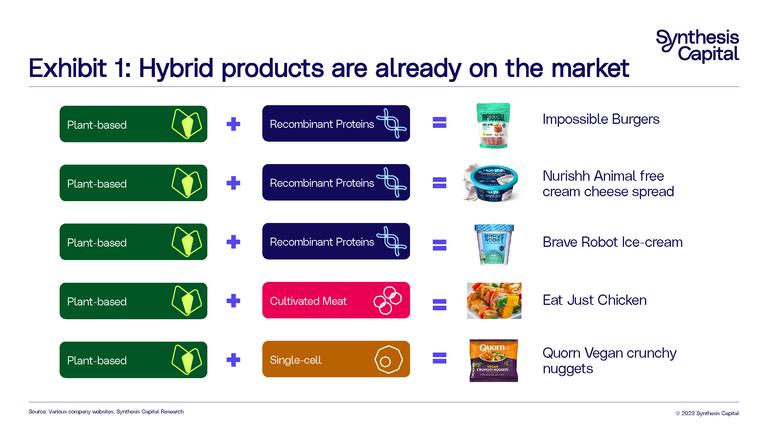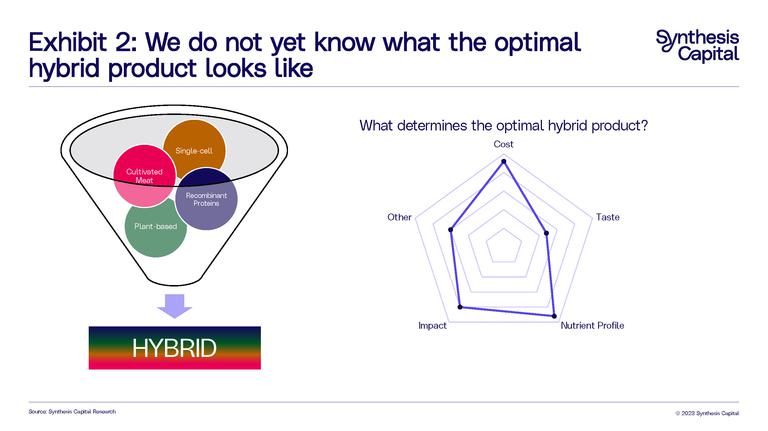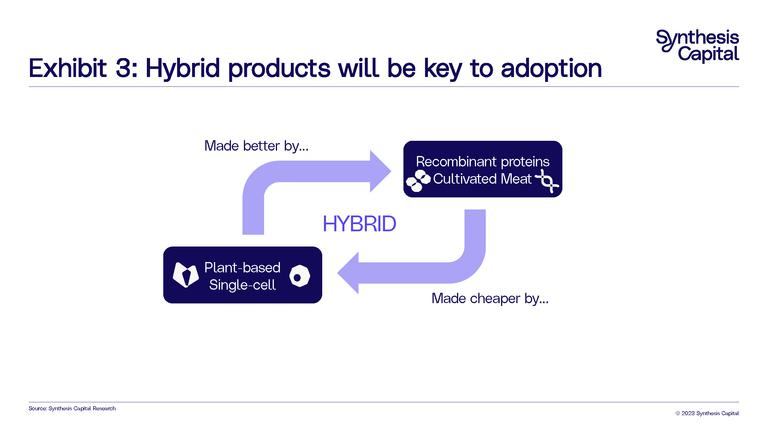Why Hybrid Products are the Key to Adoption
• Technology • Opinion
In our “Six Predictions for the Alternative Protein Sector in 2023”, we anticipated that 2023 will be the year that more of us than ever before will be eating cultivated meat, recombinant proteins, single-cell proteins, or plant-based alternatives, and this will primarily be through mixed or hybrid products where two or more of these inputs are present in one food.
This strategy is not new. Almost all the novel foods consumers are eating today are already in a hybrid formulation. Impossible burgers contain precision fermented soy leghemoglobin, and Perfect Day’s whey protein has been incorporated into a range of consumer goods from protein powder, ice‑cream, chocolate, cream cheese and most recently milk. Most cultivated meat companies are planning to enter the market with a hybrid product, and in Singapore Eat Just is already serving their chicken in restaurants – as a hybrid (Exhibit 1). When we think more about how meat is served and often even sold today – chicken nuggets, lasagnes, even sausages, all of these are examples of hybrid products.

So it's clear that hybrid products are an important part of the alternative protein growth story, necessary to get these new technologies onto the market. But which hybrid strategy will be the best? What mix of technologies will produce the winning formula for hybrid products? Is one technology likely to win in the short-term and which will be the long term winner?
Today, the potential for hybrid products in the market is significant because of the number of possible hybrid products available. Not only are there four technologies (or even five if we include animal-sourced protein) providing ingredients for these products, but these can be mixed in a number of ways to achieve the optimum taste, cost, nutrient profile, environmental impact or any other metric (Exhibit 2). This is what makes these products so exciting, the options are now exponential and we are at the start of really moving to a “build-up” rather than “break-down” food production model – with all its possible benefits.[i]

In “What are the Key Milestones for Alternative Protein Adoption to Reach S-Curve Growth?” we outlined why hybrid products are crucial to scaling up alternative protein technologies – they have the benefit of bringing down costs and improving the quality in terms of taste experience. Plant-based and single-cell proteins can make cultivated and recombinant proteins cheaper, and cultivated meat and recombinant proteins can make plant-based and single-cell based products better (Exhibit 3).

While this is a simplified representation, it illustrates just how important the hybrid strategy will be to the adoption of these technologies. We expect the number of hybrid products available to consumers to be a key barometer in understanding when these new technologies really start to become ubiquitous in the market.
Hybrid products will be key to the adoption of new food technologies that are capable of transforming our current food system.
~~~
[i] The idea of build-up vs breakdown was introduced in the Rethinking Food and Agriculture 2020-2030 report found here. Figure 10 on page 28 explains it in more detail.

